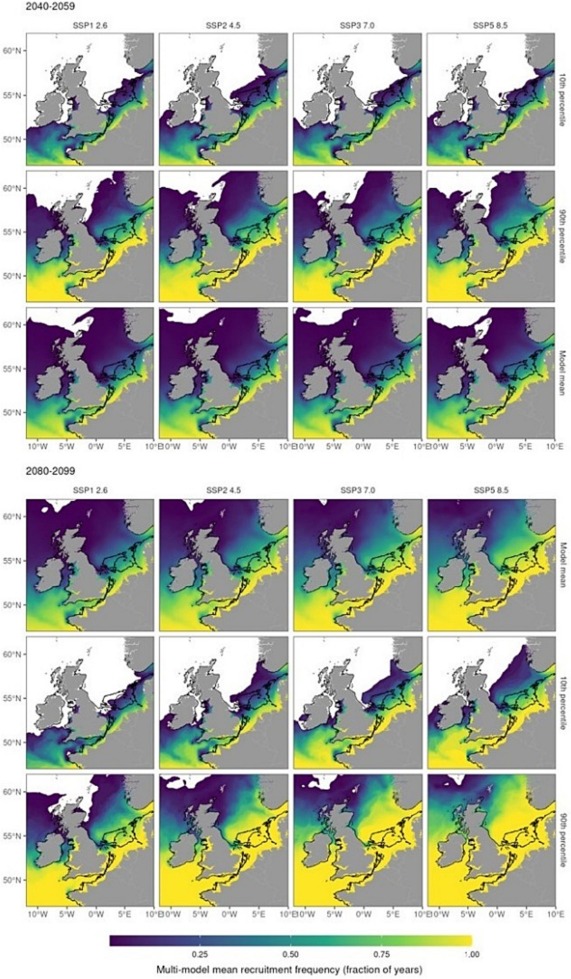Story
Non-native species in a hotter Europe: predicting the future spread of Pacific oysters
16 March 2024
 Above: A Pacific oyster - Crassostrea gigas.
Above: A Pacific oyster - Crassostrea gigas. The introduction of Pacific oysters from Japan to Europe began in the mid-1960s, and since this time Pacific oyster aquaculture has expanded dramatically - and is currently the European Union's second most important aquaculture species by economic value.
However, the geographic pattern of Pacific oyster production is set to change in a warmer future, which, whilst likely to result in positive economic benefits for those regions in terms of aquaculture, will also bring complex impacts on ecosystems and native species, which may see competition from this newly invasive species.
Until the 1990s, it was thought that Pacific oysters were mostly incapable of spawning in countries north of France due to cold waters, and were therefore incapable of becoming invasive. However, since that time, there has been an increasing number of Pacific oyster populations spread to parts of Scandanavia, the Dutch coast, the Wadden Sea, and the southern English coast - that could not be purely explained by accidental releases from aquaculture sites or ballast water.
To better understand and address the impacts of climate change on marine ecosystems, it is crucial to predict how species distributions may change. Species distribution models can play a key role by indicating to ecosystem managers and policymakers what future changes are likely to occur in marine ecosystems, so that they are able to assess whether their current or future management strategies are “climate-smart”.
However, many computer projections lack clarity on the uncertainty associated with future changes, raising doubts about their use for planning and managing ecosystems.
This uncertainty stems from three main sources: the differing potential emissions and climate scenarios we may face in the future, variability among different computer climate models, and also internal variability.
What is internal variability?
Internal variability consists of the naturally occurring variations in climate on timescales from daily weather to multidecadal processes, due to interactions between various components of the Earth system. It reflects how seemingly small differences, such as whether a volcano erupts tomorrow instead of next year, can have a large impact on the climate in future decades due to the chaotic nature of the earth system.
To address this gap, a new study led by PML’s Dr Robert Wilson, along with our Dr Susan Kay and Dr Stefano Ciavatta of Mercator Ocean International, has analysed the potential expansion of the non-native Pacific oyster in Europe by using an ensemble modelling approach.
Ensemble modelling is a process where a diverse group of models are used to project an outcome. The underlying philosophy is that the level of agreement between models can tell us something about how likely future outcomes are, and also provide a clear indication of the plausible range of possible futures.
Dr Robert Wilson said:
“Our study addressed a simple question: What matters the most when we are trying to predict how climate change will affect marine species? We addressed this by projecting the impacts of climate change on Pacific oysters in Europe using multiple climate scenarios and multiple climate models.”
“We found that the level of future emissions is critical and that climate change impacts in the high emissions SSP 8.5 scenario [see the ‘Five futures’ emissions and climate scenario decoder below*], could be more than twice as high as in the low emissions scenario SSP1 2.6 by the end of the 21st Century.”
“Importantly, the ensemble showed that the near-term changes in Pacific oysters are highly uncertain due to internal (i.e. natural) variability, which of a similar magnitute to climate model uncertainty on a 20-year timescale."

Above: Projected multi-model ensemble mean, 10th and 90th percentiles of recruitment frequency of Pacific oyster in the middle and end of the 21st Century in four climate scenarios; regions where simulated recruitment did not occur are displayed with white, as in Fig. 2 for the baseline (1995–2014) recruitment frequency.
“Our study underscores the importance of considering a range of potential scenarios rather than relying on single projections when planning for the future.”
FIVE FUTURES – DECODED*
SSP1-2.6: This is a low emissionsscenario, where global CO2 emissions are cut severely, reaching net-zero after 2050. But average global air temperature stabilize around 1.8C above pre-industrial levels by the end of the century.
SSP2-4.5: This is an intermediate emissions scenario. CO2 emissions hover around current levels before starting to fall mid-century, but do not reach net-zero by 2100. Socioeconomic factors follow their historic trends, with no notable shifts. Progress toward sustainability is slow, with development and income growing unevenly. In this scenario, temperatures rise 2.7C by the end of the century.
SSP3-7.0: On this high emissions path, emissions and temperatures rise steadily and CO2 emissions roughly double from current levels by 2100. Countries become more competitive with one another, shifting toward national security and ensuring their own food supplies. By the end of the century, average temperatures have risen by 3.6C.
SSP5-8.5: This is a very high emissions scenario. Current CO2 emissions levels roughly double by 2050. The global economy grows quickly, but this growth is fueled by exploiting fossil fuels and energy-intensive lifestyles. By 2100, the average global temperature is a scorching 4.4C higher.